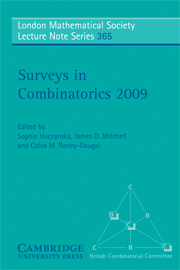Book contents
- Frontmatter
- Contents
- Preface
- 1 Graph decompositions and symmetry
- 2 Combinatorics of optimal designs
- 3 Regularity and the spectra of graphs
- 4 Trades and t-designs
- 5 Extremal graph packing problems: Ore-type versus Dirac-type
- 6 Embedding large subgraphs into dense graphs
- 7 Counting planar graphs and related families of graphs
- 8 Metrics for sparse graphs
- 9 Recent results on chromatic and flow roots of graphs and matroids
1 - Graph decompositions and symmetry
Published online by Cambridge University Press: 05 May 2013
- Frontmatter
- Contents
- Preface
- 1 Graph decompositions and symmetry
- 2 Combinatorics of optimal designs
- 3 Regularity and the spectra of graphs
- 4 Trades and t-designs
- 5 Extremal graph packing problems: Ore-type versus Dirac-type
- 6 Embedding large subgraphs into dense graphs
- 7 Counting planar graphs and related families of graphs
- 8 Metrics for sparse graphs
- 9 Recent results on chromatic and flow roots of graphs and matroids
Summary
To the memory of Adriano Barlotti and Lucia Gionfriddo
Abstract
In this paper I shall try to review some results which were obtained in the area of factorizations and decompositions of complete graphs admitting an automorphism group with some specified properties. These properties primarily involve the action of the group on the objects of the decomposition, most often vertices, but also edges, subgraphs of the decomposition or factors of the factorization.
Classification theorems were obtained in highly symmetric situations, for example when the group acts doubly transitively on vertices, and it is often the case that all examples arise from geometry in this context.
A “less” symmetric situation involves a group acting sharply transitively on vertices, which means for any two given vertices there exists precisely one group element mapping the first vertex to the second one. The vertices of the complete graph can be identified with group elements in this case, and the decomposition or factorization can be described entirely within the group by techniques which are generally known as “difference” or “starter-like” methods. Existence may be a non-trivial question and generally depends on the isomorphism type of the chosen group.
- Type
- Chapter
- Information
- Surveys in Combinatorics 2009 , pp. 1 - 18Publisher: Cambridge University PressPrint publication year: 2009

